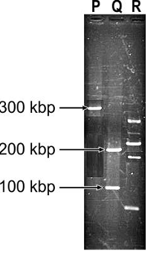Nidhi performed gel electrophoresis after treating one vector with restriction enzymes. She added one mixture in well Q and another mixture in well R. Given below is an image of the results.

What is the likely reason that the fragments in wells Q and R are different?

Important Questions on Biotechnology - Principles and Processes
Following statements describe the characteristics of restriction endonucleases. Identify the incorrect statement.

Which one of the following sets of DNA fragments generated by digestion with both Eco RI and Bam HI as shown in (iii) is from the gene?
Study the following lists:
| List- | List- | ||
| A. | Eco RI | Vector for transgenic plants | |
| B. | Ti plasmid | Restriction enzyme | |
| C. | pBR | Probe | |
| D. | Reverse transcriptase | RNA dependent DNA synthesis | |
| Artificial plasmid |
The correct match is
Match the following lists:
| List | List | ||
| A) | Hind | pBR | |
| B) | Eco RI | Replication of the plasmid | |
| C) | Hind | First restriction endonuclease | |
| D) | rop codes | E. coli Ry |
The correct match is
Consider the linear double-stranded DNA shown below. The restriction enzyme sites and the lengths demarcated are shown. This DNA is completely digested with both Eco and Bam restriction enzymes. If the product is analyzed by gel electrophoresis, how many distinct bands would be observed?


